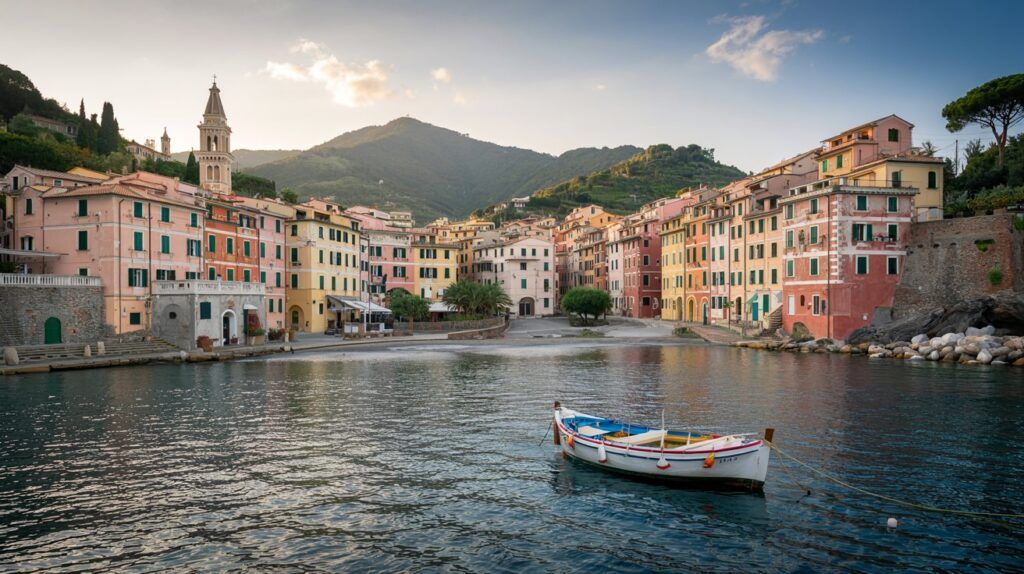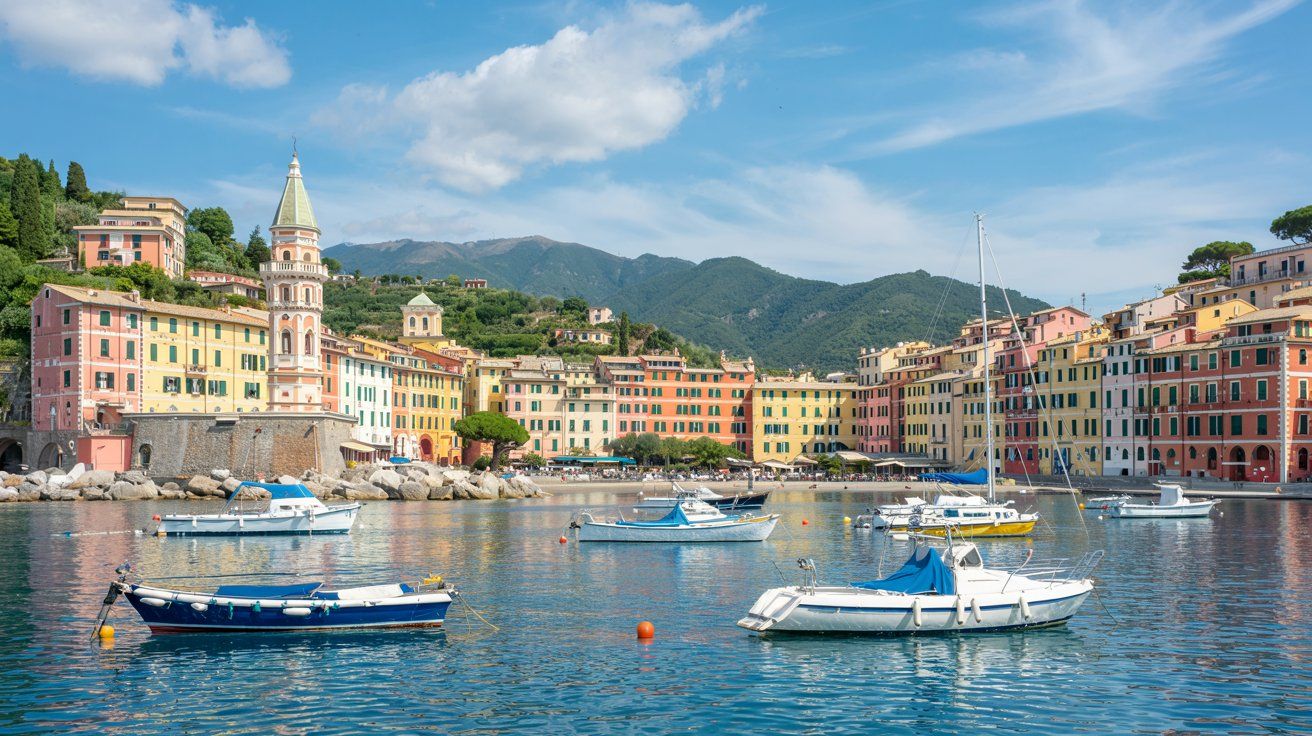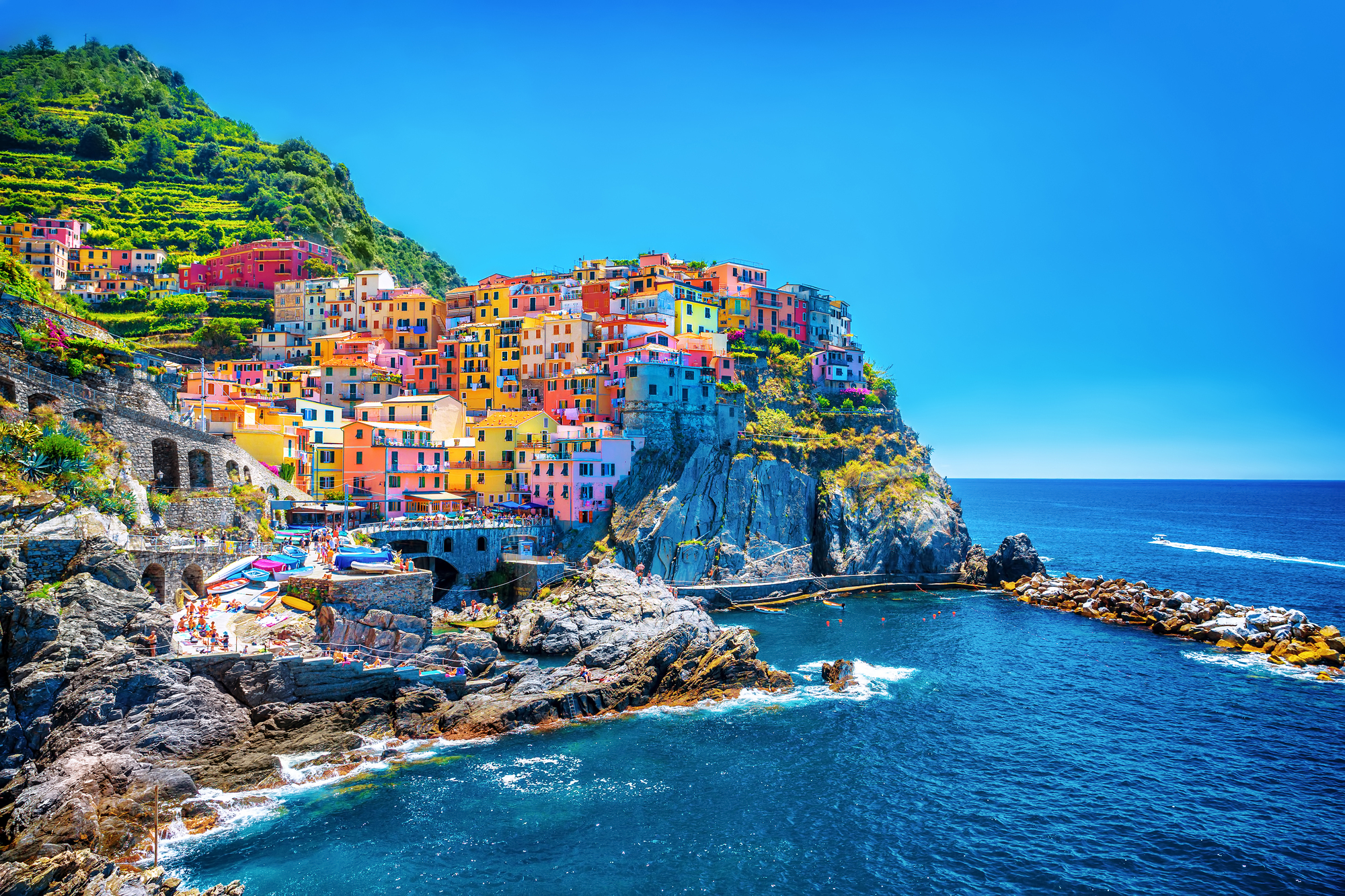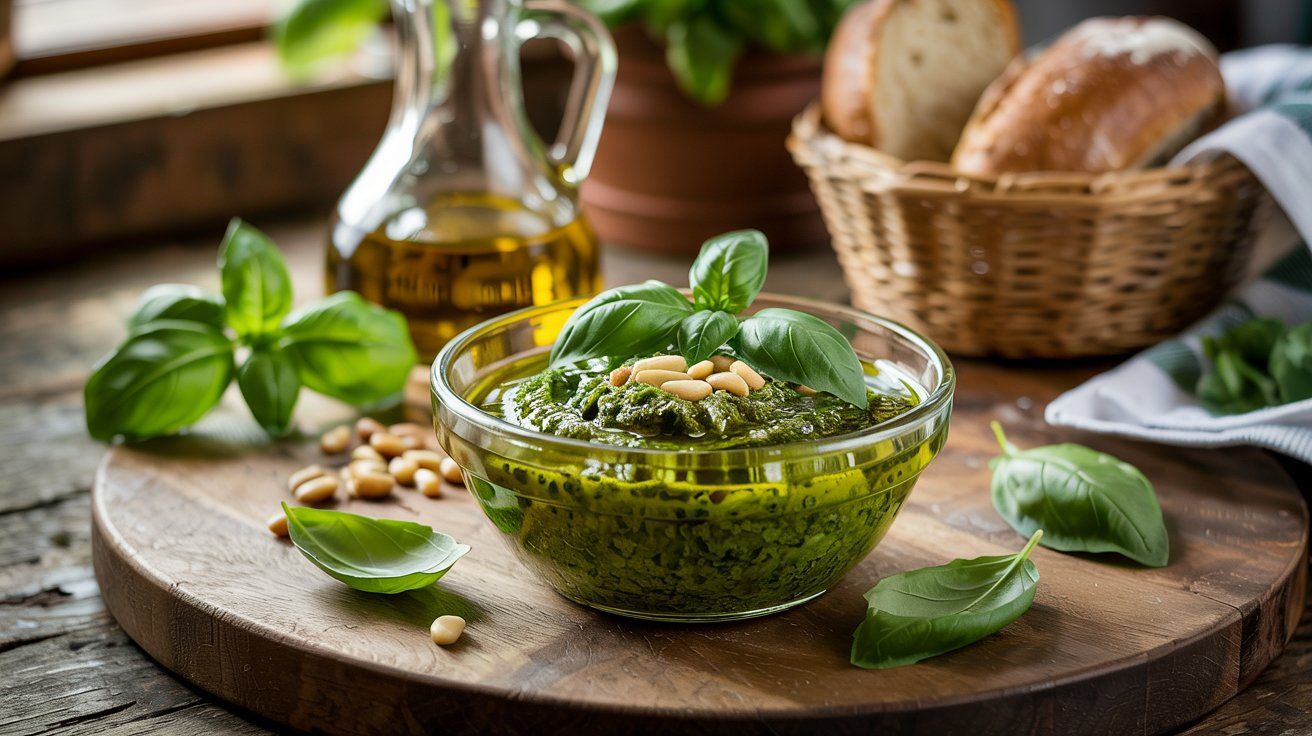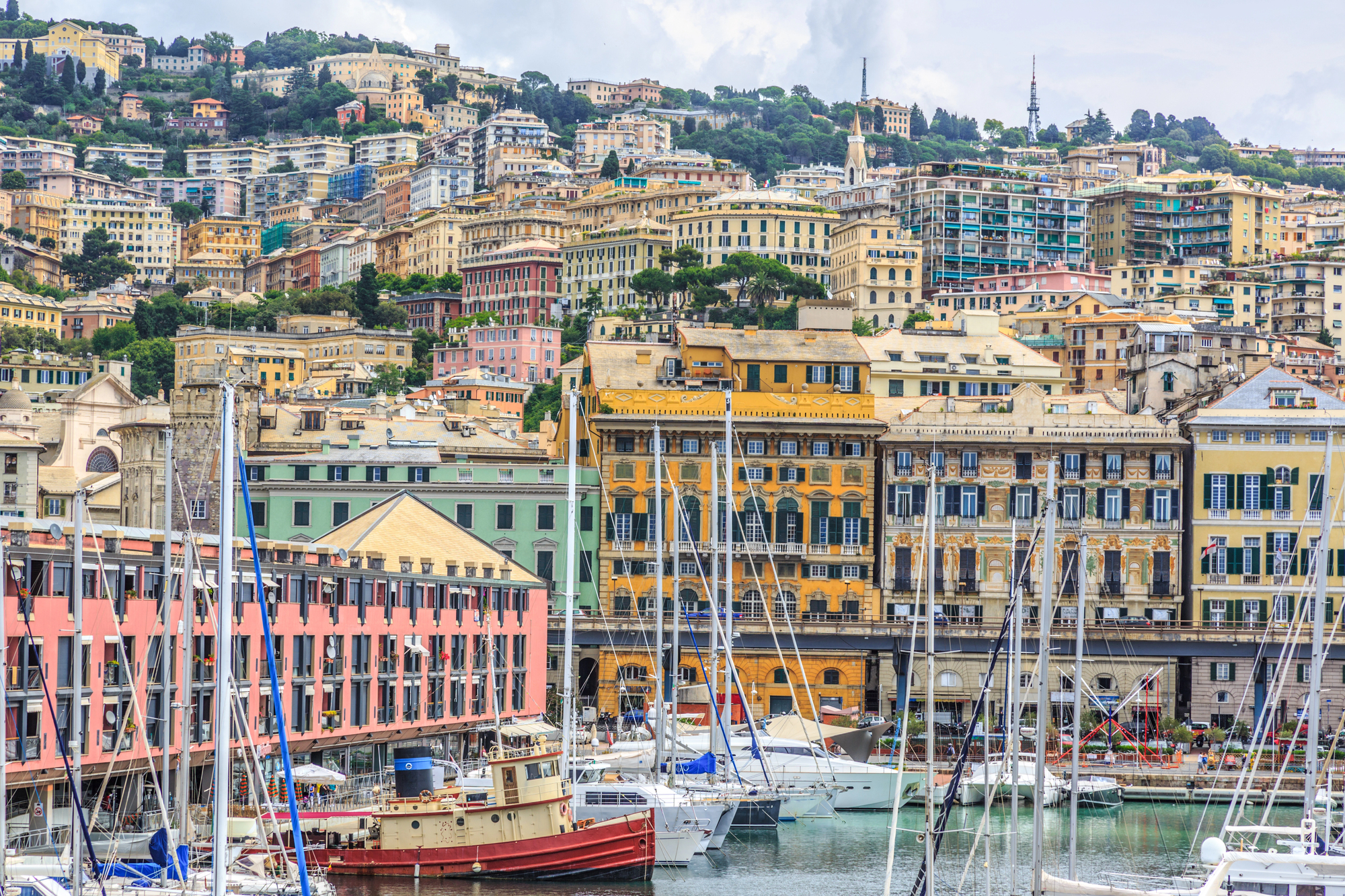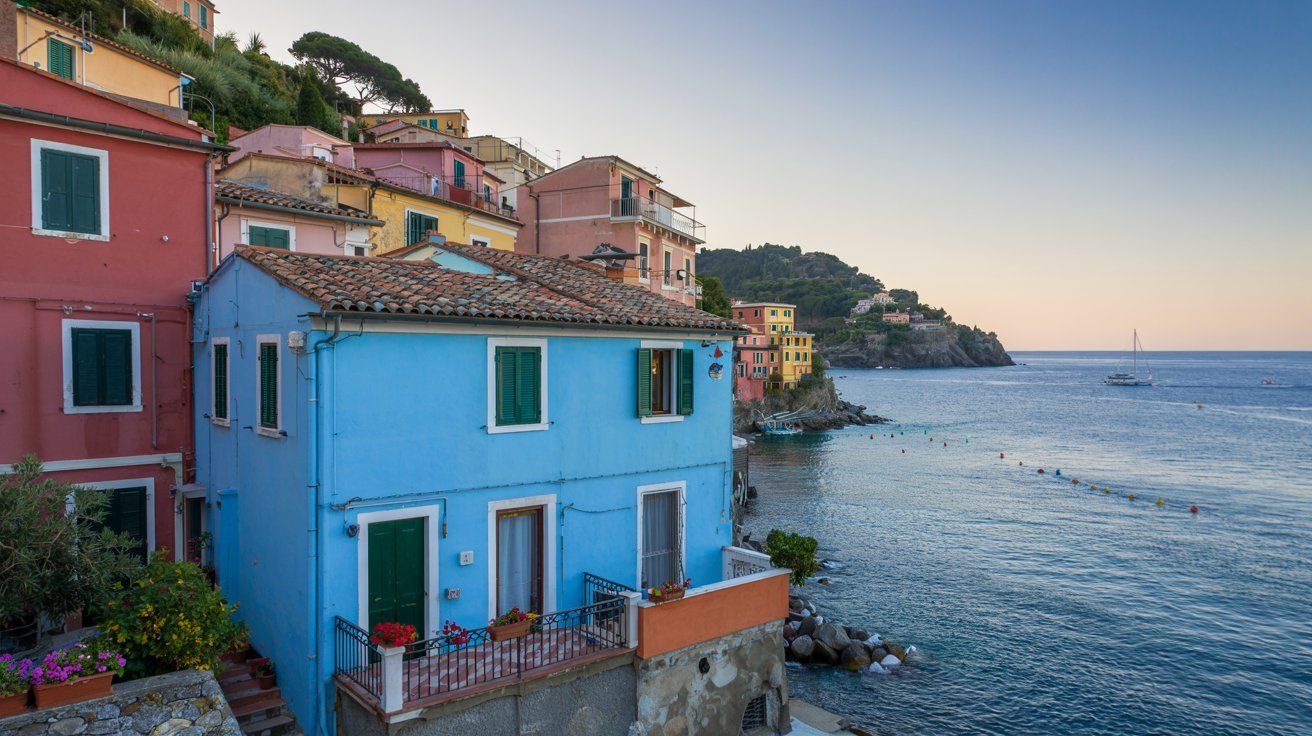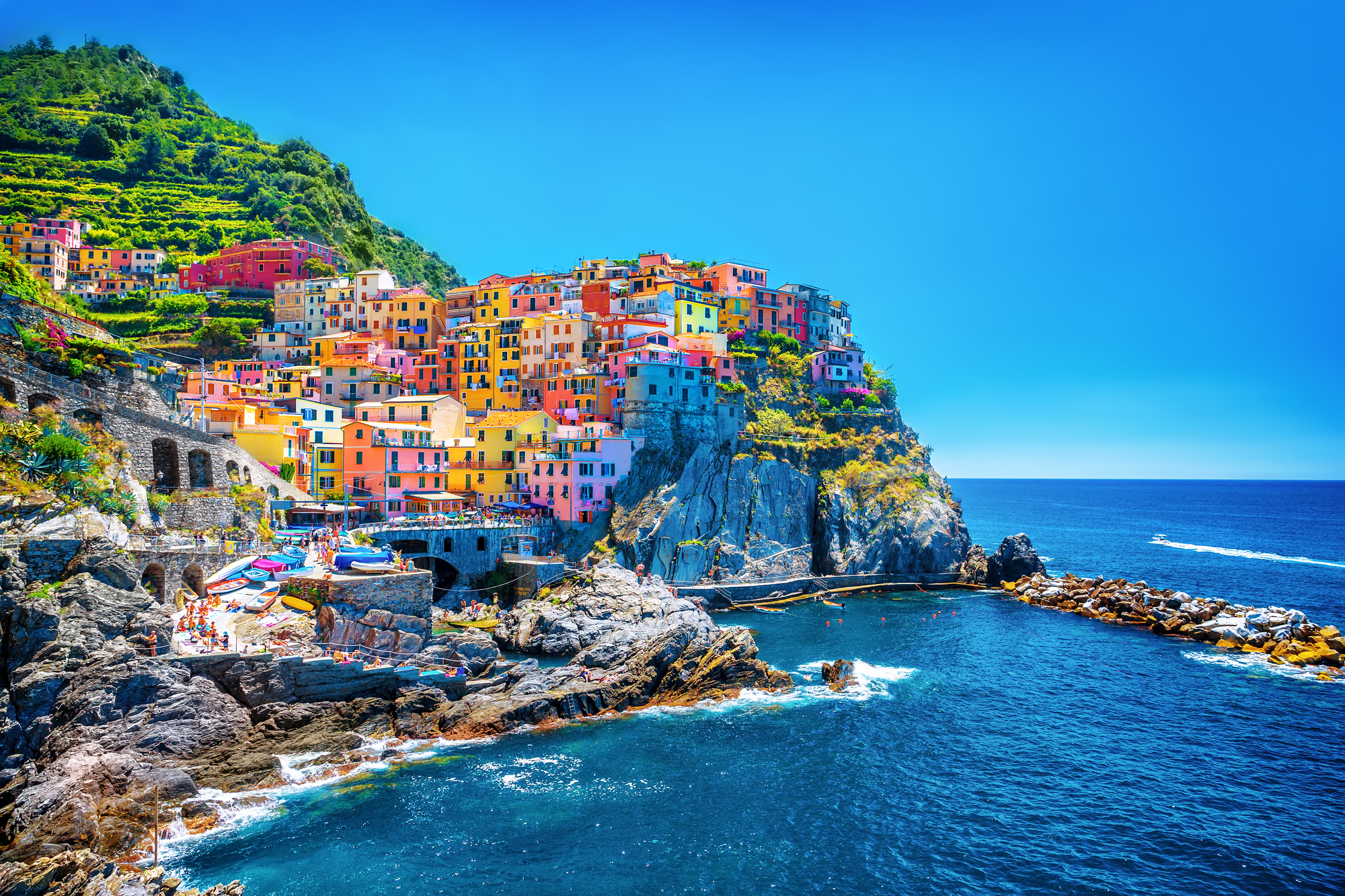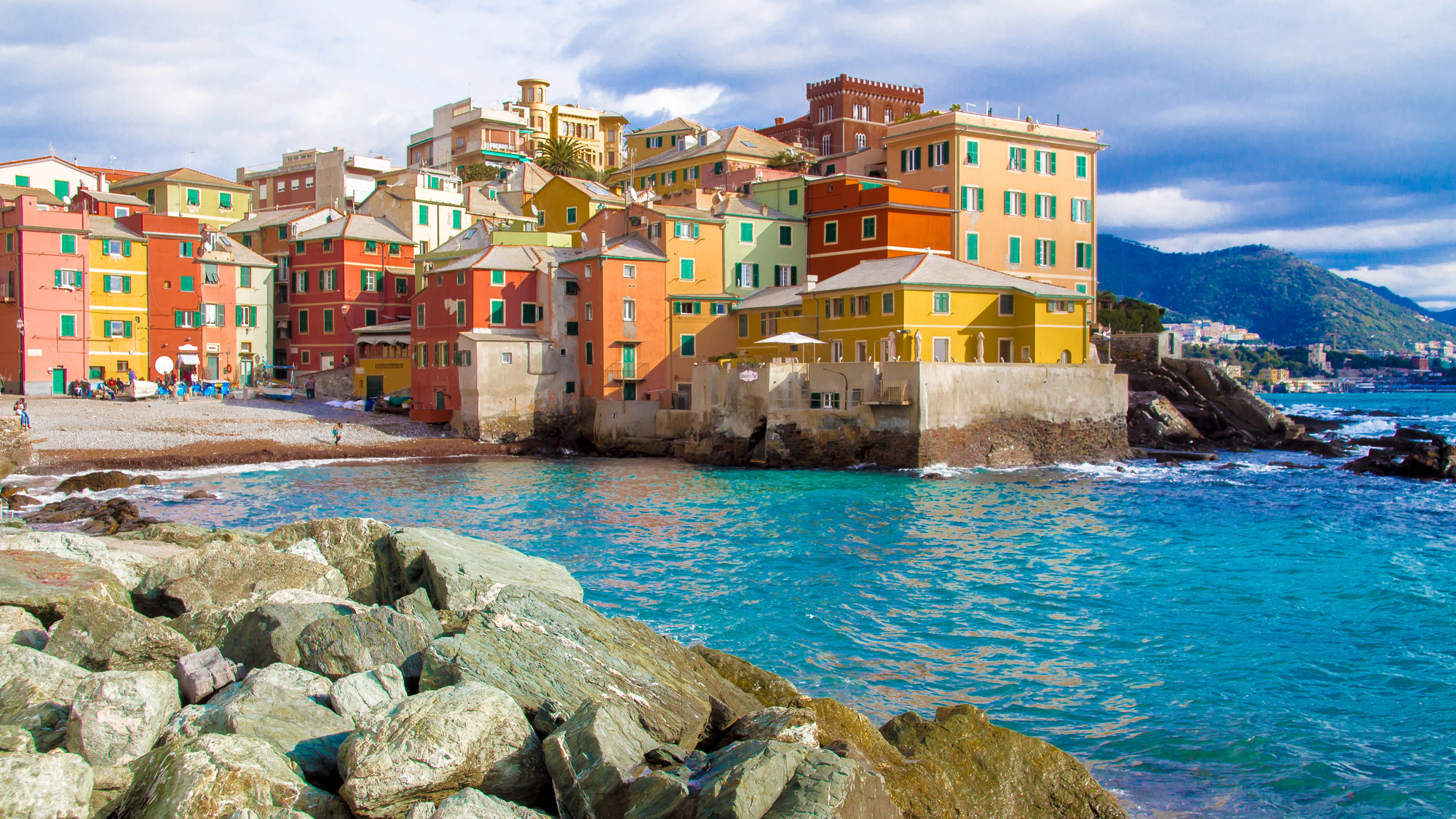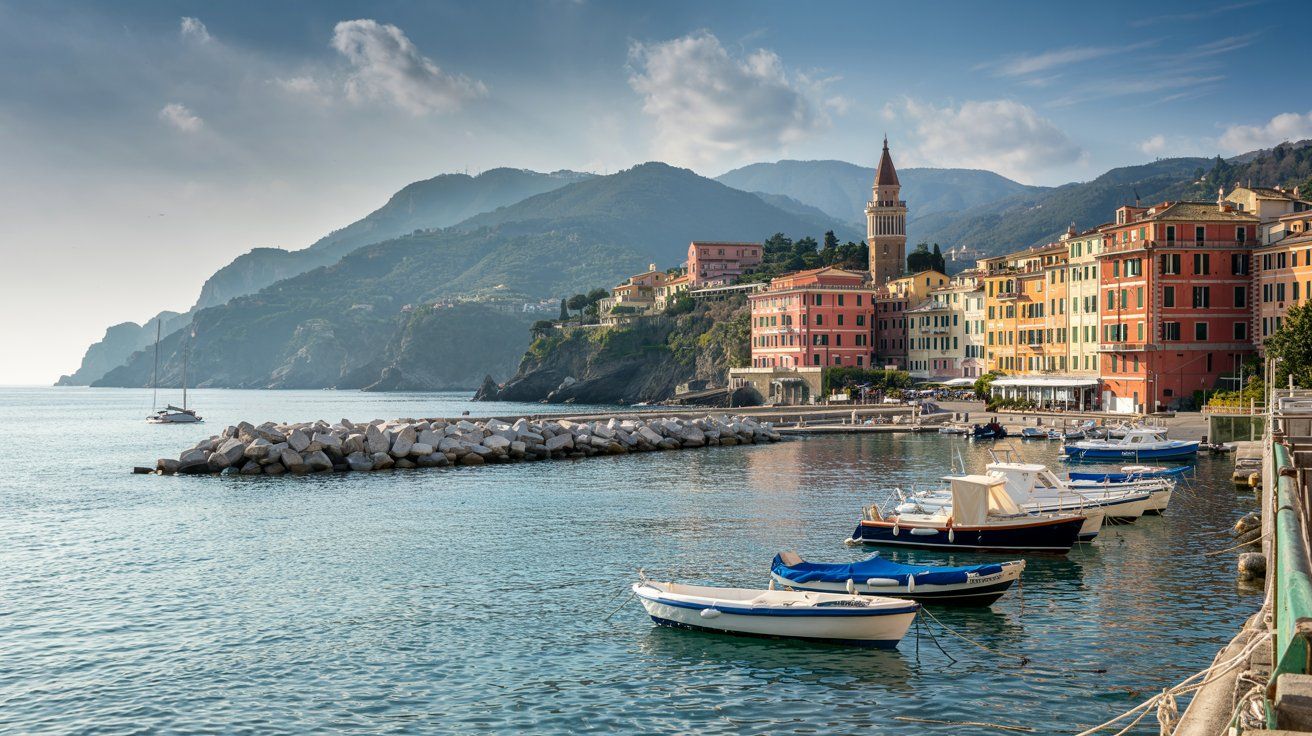The Italian Riviera draws in travelers with its sparkling blue waters and charming coastal towns. Honestly, getting there is simpler than most folks think, and there are plenty of ways to make the trip, whether you’re watching your budget or just want a smooth ride.
Flying into Genoa Cristoforo Colombo Airport is hands-down the easiest way to reach the Italian Riviera. This airport handles both domestic and international flights, so you’ve got options. Once you land, it’s a breeze to hop on a train and head straight to hotspots like Rapallo, Santa Margherita Ligure, or any of the other coastal gems. The trains run often and make a practical choice, especially if you’re coming from bigger cities like Milan—it’s only about a two-hour direct train ride.
Get a discount of 15% to 70% on accommodation in Genoa! Look for deals here:
Genoa Hotels, Apartments, B&Bs
If you’re already in Italy, the train system makes the Riviera super accessible. A lot of people choose Rapallo as their base because everything along the coast is just a short ride away. You can easily bounce between towns without dragging your luggage everywhere or fussing with a rental car. That means more time for dipping your toes in those blue waters, hunting for hidden beaches, or soaking up the laid-back coastal vibe.
Overview of the Italian Riviera
The Italian Riviera hugs the Ligurian coastline, mixing together colorful fishing villages, elegant resort towns, and some seriously gorgeous scenery. It’s a place where you get beautiful beaches, a dash of history, and food that’ll make you want to linger at the table.
Geography and Regions
The Riviera stretches out along Italy’s northwestern coast in Liguria. People usually split it into two parts: the Riviera di Ponente (“coast of the setting sun“) to the west of Genoa, and the Riviera di Levante (“coast of the rising sun”) to the east.
Riviera di Ponente runs from the French border to Genoa, with wide beaches and resort towns like San Remo and Alassio. It’s usually less crowded and a bit easier on your wallet.
Riviera di Levante goes from Genoa to Tuscany and includes the famous Cinque Terre, Portofino, and the Gulf of Poets. This side is all about dramatic cliffs, colorful villages, and a more upscale feel.
The coastline sits behind the Maritime Alps and Apennines, which protect it and help keep the weather mild year-round.
Best Time to Visit
If you’re looking for the sweet spot, spring (April-May) and early fall (September-October) usually hit the mark. The weather is pleasant, crowds are lighter, and you can actually find a spot on the beach. Temps hover between 65-75°F (18-24°C)—pretty much perfect for wandering the towns or hiking the trails.
Summer (June-August) is all about hot, sunny days. The beaches fill up, prices jump, and every town feels lively. Festivals and events kick into high gear, so if you like a buzz, this is your season.
Winter (November-March) is much quieter. You’ll see fewer tourists and snag better deals, but some restaurants and attractions slow down or take a break. Still, you won’t freeze—temps rarely dip below 50°F (10°C).
If you can, skip August. That’s when most Italians go on vacation, and the Riviera gets absolutely packed.
Cultural Highlights
Food is the heart of life on the Riviera. You’ve got to try Ligurian classics like pesto (yep, it started here), focaccia, and whatever seafood is fresh that day. Locals really care about simple, honest ingredients and flavors that speak for themselves.
Fishing still matters here. You’ll spot bright boats bobbing in harbors like Camogli and Vernazza, and many towns throw festivals or boat races to celebrate their seafaring roots.
Art and architecture have left their mark too. Genoa’s palaces tell stories of wealthy medieval traders, while smaller towns show off painted facades and ornate churches.
The Riviera has always attracted creative souls—Hemingway, Byron, Shelley—all found inspiration here, drawn in by the light, the sea, and the relaxed pace.
Main Gateways to the Italian Riviera
You can get into the Italian Riviera through several main entry points, and each has its perks depending on where you’re coming from and what you want to see.
Arriving via Genoa
Genoa is kind of the main front door to the Riviera. As Liguria’s capital, it’s got excellent transport links. The Cristoforo Colombo Airport connects to major European cities, so international travelers can land here without too much hassle.
From Genoa’s central station, trains run up and down the coast all day. If you’re heading east, you’ll reach places like Rapallo, Santa Margherita Ligure, and Cinque Terre. Head west for the Riviera di Ponente.
The port brings in cruise ships and ferries from places like Barcelona, Sardinia, and Sicily. If you’re driving, the A10 highway hugs the coast and makes it easy to reach most towns.
Access from Tuscany
Lots of people pair a trip to the Riviera with a visit to Tuscany. La Spezia is the main connecting point between the two.
Regional trains from Florence and Pisa reach La Spezia in about 2-2.5 hours. From there, you can jump on local trains to Cinque Terre and other eastern Riviera towns.
If you’re behind the wheel, the A12 highway links Tuscany to the Riviera, and the drive from Florence to La Spezia takes about two hours.
There are bus services between major Tuscan cities and Riviera towns, but honestly, trains are more reliable and frequent.
Connecting through France
On the western end, the Italian Riviera blends right into the French Riviera at Ventimiglia. It’s a handy entry if you’re coming from France.
International trains from Nice and Monaco roll into Ventimiglia regularly. The trip from Nice takes about 40 minutes—a quick hop over the border.
By car, the A10 turns into the A8 once you cross into France. The drive along the coast, especially between Nice and Ventimiglia, is gorgeous and passes through pretty towns like Menton.
In summer, ferries run between French ports and western Riviera towns. It’s a nice change of pace from road or rail if you’re not in a rush.
Traveling by Train
Taking the train is probably the smartest way to get around the Italian Riviera. The tracks run right along the coast, and you get sea views that are hard to beat.
Key Train Routes
The main railway hugs the coast from Ventimiglia at the French border all the way to La Spezia, hitting all the key towns.
Here’s how the main segments break down:
- Ventimiglia to Genoa: The western stretch, with stops like Imperia and Savona
- Genoa to La Spezia: The eastern part, including the Cinque Terre villages
- Milan to La Spezia: Direct trains get you from Milan to the Riviera in about three hours
Regional trains (Regionale) stop everywhere, while Intercity and Frecciabianca only hit bigger towns. If you want to check out the smaller villages, stick with the regional trains—they run more often and stop in more places.
Travel Times and Schedules
Here’s a quick look at typical travel times:
| Route | Duration | Train Type |
|---|---|---|
| Milan to La Spezia | 3 hours | Direct/Intercity |
| Genoa to Cinque Terre | 1-1.5 hours | Regional |
| Ventimiglia to Genoa | 2 hours | Regional |
| Savona to Genoa | 40 minutes | Regional |
Trains run pretty much all day, every 30-60 minutes on most regional lines. First trains usually start around 5:30 AM, and the last ones run until midnight.
If you’re traveling during peak season (June-September), expect more people, especially on the Cinque Terre trains. Mornings are usually less crowded than afternoons.
Train Stations in Major Towns
Main train stations sit right in the heart of most Riviera towns, so you can start exploring as soon as you step off.
Genoa has a few stations, but Genova Piazza Principe and Genova Brignole are the big ones. Piazza Principe is closer to the old city and the port.
La Spezia Centrale is your jumping-off point for Cinque Terre and connects to Florence and other inland spots.
Ventimiglia sits right at the border and has direct trains to Nice and Monaco.
Savona and Imperia stations are close enough to walk from the center or the beach.
You’ll find basics like ticket offices, waiting rooms, and snack stands at most stations.
Booking Tickets and Tips
You can buy train tickets in a few different ways:
- Online: Trenitalia website (trenitalia.com) or app
- Ticket machines: At every station
- Ticket counters: Open during main hours
- Travel agencies: Good for more complicated trips
For regional trains, buying tickets at the station is usually fine. Just don’t forget to validate your ticket in the little green machines on the platform before you board.
A few ways to save money:
- Cinque Terre Card: Unlimited train rides between La Spezia and Levanto
- Regional passes: Great for multiple trips within an area
In summer, trains can get packed. Traveling early or late in the day helps. Pack light—storage space is tight on regional trains.
Get a discount of 15% to 70% on accommodation in Genoa! Look for deals here:
Genoa Hotels, Apartments, B&Bs
Exploring by Ferry
Taking a ferry gives you a whole new view of the Riviera. Seeing the villages from the water is something special, and sometimes it’s just more relaxing than hopping on a train.
Ferry Routes and Destinations
Ferries connect key spots up and down the coast. In Cinque Terre, boats run between all the villages except Corniglia (no harbor there). These ferries usually stop at Monterosso, Vernazza, Manarola, and Riomaggiore.
Portovenere is a key hub, linking the Gulf of Poets with Cinque Terre. From here, you can catch a boat to Lerici or other pretty spots around the gulf.
If you’re near Portofino, ferries run from Santa Margherita Ligure and Rapallo. It’s a nice way to reach the peninsula without stressing about parking or crowded buses.
During peak season, longer routes run between towns like Rapallo, Santa Margherita Ligure, and Cinque Terre.
Seasonal Ferry Service
Ferries mostly run from April to the end of October, with the busiest schedules in summer (June-September).
Weather can mess with ferry schedules—rough seas sometimes mean last-minute cancellations, especially in spring and fall. Don’t count on ferries 100% if your plans are tight.
Some routes run less often in early spring or late fall. For example, the Rapallo to Cinque Terre line usually goes once a day from April through September.
In winter, almost all ferries stop running (November-March). You’ll have to stick to trains or buses during those months.
Buying Ferry Tickets
Pick up ferry tickets at the harbor ticket offices in each town. These usually open about 30 minutes before the first boat leaves.
If you’re traveling in July or August, get there early—lines can get long, and popular routes sometimes sell out for the day.
Ticket prices depend on how far you’re going. If you plan to hop between villages, a day pass for unlimited rides in Cinque Terre is your best bet.
Most places take credit cards, but smaller companies may want cash. Carry some euros just in case.
You can’t book regular ferry tickets in advance; they’re sold first-come, first-served. If you’re with a big group, show up early to make sure you all get on the same boat.
Access by Car and Road Travel
Driving gives you the freedom to explore out-of-the-way spots along the Riviera that trains miss. The coastal roads deliver jaw-dropping sea views, but you’ll need to plan ahead for parking and watch out for restricted zones.
Driving Routes and Road Conditions
The A10 highway (Autostrada dei Fiori) runs right along the coast from Genoa to Ventimiglia, acting as the main route into the Italian Riviera. You’ll find exits for coastal towns like Rapallo, Finale Ligure, and Sanremo. The road usually stays in good shape, but in summer or during Italian holidays? Traffic can be a headache.
If you want more scenery (and maybe a little adventure), the SS1 Via Aurelia hugs the coastline and winds its way through Liguria. It’s narrow and twisty, so you’ve got to stay alert, but the views are worth it—even if you’re not breaking any speed records.
Most winters, driving’s a breeze, though rainstorms sometimes make the coastal roads slick. Gas stations pop up regularly along the A10, but they’re sparse on the smaller roads, so don’t push your luck on an empty tank.
Parking and ZTL Zones
Parking in Riviera towns is, honestly, a challenge—especially once summer rolls around. Historic centers almost never have parking, so aim for the official parking lots (parcheggi) outside towns like Rapallo or Finale Ligure.
You’ll also run into ZTL zones (Zona Traffico Limitato), which restrict traffic to locals and authorized vehicles. Cameras keep watch, and if you drive in by mistake, expect a hefty fine—usually €80-100. Not fun.
In Sanremo, underground garages make life easier, but they’ll cost you (€2-3 per hour). If you’re aiming for a spot in a smaller town during peak season, better get there early.
Blue-lined street parking means you’ll need to pay at a ticket machine nearby. Stick the ticket on your dashboard or you’ll risk a fine.
Coastal Scenic Drives
The 161km Italian Riviera Panoramic Road from Genoa to Ventimiglia easily ranks among Italy’s most stunning drives. You’ll pass through fishing villages and get endless photo ops over the Ligurian Sea.
Between Finale Ligure and Noli, the road clings to dramatic cliffs above hidden coves. You’ll want to pull over at the belvedere viewpoints—seriously, don’t just drive past.
The drive from Rapallo to Portofino is another favorite. It’s twisty and narrow, but if you go slow, you’ll catch glimpses of luxury yachts and those emerald waters. Plus, you’ll end up near some exclusive beaches and restaurants.
If you want to dodge the crowds, try the inland roads through Ligurian hill towns. They eventually drop you back to the coast and show off a different side of the region.
Key Destinations Along the Riviera
The Italian Riviera is packed with standout places, each with its own flavor. Whether you’re drawn to Cinque Terre’s colorful cliffs or Portofino’s glitzy harbor, you’ll find a mix of rustic charm and sleek sophistication.
Cinque Terre
Cinque Terre is made up of five vibrant fishing villages perched on the Ligurian cliffs: Monterosso al Mare, Vernazza, Corniglia, Manarola, and Riomaggiore. You can hike between them or hop on the regional train.
Cinque Terre is a national park and UNESCO site now, and cars are mostly banned—so you get that real, old-world vibe.
Each village brings something unique. Monterosso has the best beaches, Vernazza’s natural harbor is ringed by colorful houses, and Corniglia sits high up, with 382 steps from the train station to reach it (yep, I counted).
Manarola and Riomaggiore offer some of the best views, with bright houses tumbling down to the sea. The famous Via dell’Amore (Lovers’ Lane) trail links them—at least, the parts that are open.
Portofino and Surroundings
Portofino started as a fishing village but now feels like Italy’s answer to St. Tropez. Its curved harbor, packed with yachts, looks like it belongs on a postcard.
The village center is tiny but stylish, with upscale boutiques, top-notch seafood, and buildings in every shade of the rainbow. Walk up to Castello Brown for sweeping views over the harbor and coastline—it’s a short climb.
Just nearby, the Abbey of San Fruttuoso hides in a tiny cove and you can only get there by boat or hiking. This 10th-century monastery sits tucked between green hills and the sea.
Camogli, which doesn’t get the same crowds, offers a more down-to-earth vibe. It’s got those classic Ligurian houses, a pebbly beach, and a slower pace—perfect if you need a break from the glitz.
Santa Margherita Ligure
Santa Margherita Ligure feels elegant but less showy than Portofino. The palm-lined promenade, dotted with pastel-colored Liberty-style buildings, sets a relaxed mood.
Here, you get a nice mix of tourist spots and genuine Italian life. Seafood restaurants, gelaterias, and cafes attract both locals and visitors.
Villa Durazzo sits above the bay, surrounded by terraced gardens. It’s a peaceful hideaway if the town center gets too busy, and you can check out its art collections or join a guided tour.
Santa Margherita makes a great base. Ferries run to Portofino, San Fruttuoso, and other towns, and the train station connects you quickly to Genoa, Cinque Terre, and other Riviera landmarks.
Gulf of Poets Towns
The Gulf of Poets (Golfo dei Poeti) got its name from inspiring writers like Byron and Shelley. Lerici, the main town, stands out with its medieval castle towering over a colorful harbor.
Porto Venere, just down the coast, has narrow medieval streets leading to the Church of St. Peter, perched on cliffs above the sea. This UNESCO site boasts killer views of the Palmaria, Tino, and Tinetto islands.
Tellaro, a tiny fishing village, remains a real hidden gem. Its red and orange houses cluster around a peaceful harbor, far from the crowds.
In summer, ferries link these towns, so you can soak up the gulf from the water. The beaches here usually stay quieter than those further west—nice if you want to relax.
Popular Towns and Cities
The Italian Riviera strings together a bunch of coastal towns, each with its own twist. From Sanremo’s flower-lined streets to Portofino’s ritzy harbor, you get Mediterranean beauty and authentic Italian culture in one go.
Imperia and Surroundings
Imperia blends two old centers—Porto Maurizio and Oneglia—joined by a seaside promenade. The city’s olive oil is famous across Italy, and plenty of local producers open their doors for tastings.
The Parasio district, dating back to the 11th century, winds up the hillside with narrow medieval lanes. The Duomo di San Maurizio, with its huge dome, stands out on the skyline.
Nearby villages worth a detour:
- Cervo: A perfectly preserved medieval town with epic sea views
- Diano Marina: Family-friendly beaches and great food
- Dolceacqua: Inland, with a quirky humpback bridge Monet once painted
Beaches around here don’t get as crowded as the big-name Riviera spots, so you can actually unwind and still soak up the scenery.
Finale Ligure and the Riviera di Ponente
Finale Ligure brings together three areas: Finale Marina (beachfront), Finalborgo (walled medieval village), and Finale Pia. The beaches are wide and clear, backed by dramatic limestone cliffs.
Finalborgo stands out as one of Italy’s most beautiful villages (Borghi più belli d’Italia), with its old walls and lively squares. Piazza Tribunale fills up with markets and events on summer evenings.
Outdoor lovers flock to Finale for:
- Rock climbing on the famous limestone cliffs
- Mountain biking through coastal forests
- Coastal hikes with jaw-dropping views
The wider Riviera di Ponente is dotted with quieter towns like Noli and Varigotti, where fishing traditions live on. Local restaurants serve up the catch of the day with pesto and focaccia.
Rapallo and the Tigullio Gulf
Rapallo works well as a base for exploring the Tigullio Gulf. This elegant seaside town has a small castle watching over the harbor and a historic center full of shops and cafes.
Take the cable car up to Montallegro Sanctuary for sweeping gulf views. From Rapallo, you can hop on a boat or bus to Portofino.
Nearby highlights:
- Santa Margherita Ligure: Refined resort, colorful buildings
- Portofino: Iconic harbor, luxury shopping
- San Fruttuoso: Secluded abbey, only accessible by boat or on foot
The Tigullio area keeps a nice balance between fancy resorts and the real Italy. Seafood rules here—acciughe (anchovies) come in all sorts of traditional recipes.
Sanremo: The City of Flowers
Sanremo got its “City of Flowers” nickname thanks to its flower industry, which ships blooms all over Europe. The mild climate means palm trees and lush gardens year-round.
The old La Pigna quarter climbs up the hillside in circles, with a maze of alleys, archways, and little squares. It feels worlds apart from the Art Nouveau buildings lining the main streets.
Check out:
- Casino di Sanremo, a belle époque gambling palace
- The Russian Orthodox Church with its onion domes
- Villa Ormond and Villa Nobel, both with gorgeous gardens
Sanremo hosts Italy’s big music festival every February and plenty of cycling events. The weekly market along the lungomare (seafront) is a good spot for local produce, clothes, or souvenirs.
Get a discount of 15% to 70% on accommodation in Genoa! Look for deals here:
Genoa Hotels, Apartments, B&Bs
Regional Travel Tips and Practical Advice
Getting around the Italian Riviera is easier when you know a few tricks. The right transport, comfy places to stay, and smart day trips can really boost your Ligurian adventure.
Local Transportation Options
Trains are your best bet for getting around the Riviera. Regional trains link almost all the coastal towns, and they’re cheap and scenic. If you’re coming from France, hop on the TER train from Nice to Ventimiglia (about 50 minutes), then switch to Italian regional trains.
In Cinque Terre, a dedicated train shuttles between the five villages all day. Grab a Cinque Terre Card for unlimited train rides and trail access.
Boats run between coastal towns in summer, and the views from the water are unbeatable.
Local buses go inland, though schedules can get spotty off-season.
Renting a car gives you freedom, but parking and narrow roads are a pain in the coastal towns. It’s usually easier to leave the car at your hotel and use public transport to get around.
Accommodation Choices
The Italian Riviera has loads of accommodation to suit all kinds of travelers. Book ahead if you’re coming in high season (June-September).
Boutique hotels in places like Portovenere, Santa Margherita, and Rapallo offer comfort and local charm. Most include breakfast with Ligurian treats.
Apartments and vacation rentals are great for families or longer stays, letting you cook with local ingredients.
Agriturismo (farm stays) up in the hills give you a taste of authentic life, home-cooked meals, and quiet surroundings—ideal for hikers.
If you’re on a budget, hostels in La Spezia or Genoa make a good base for day trips to Cinque Terre, since staying in the villages can get pricey.
If you do stay in Cinque Terre, remember: lots of places involve steep stairs, so pack light and check accessibility before you book.
Planning Day Trips
The Italian Riviera’s compact layout makes day trips feel genuinely rewarding. If you want to make the most of your time, keep an eye on train schedules—they’ll shape your day, whether you like it or not.
Cinque Terre villages get crowded fast, so honestly, it’s worth setting out early (think before 9 AM) if you want to soak in the atmosphere without the crowds. You’ll want at least a couple of hours—maybe three—in each village to really get a feel for them.
If you’re up for something different, Portofino’s harbor views are gorgeous, and Camogli has that old-school fishing village vibe with way fewer tourists hanging around.
Give Genoa a whole day; you’ll need it. The city’s historic center, grand palaces, and the massive aquarium (yeah, Italy’s biggest) can easily fill your schedule.
Hikers, don’t just wing it—look up trail conditions first. Sometimes paths close because of landslides, and that can mess up plans. The Sentiero Azzurro, connecting the Cinque Terre villages, needs a ticket during the busy months, so keep that in mind.
If the hustle of busy towns wears you out, try slipping away to quieter places like Tellaro or Lerici on the Gulf of Poets. Life there just kind of rolls on as it always has, and honestly, that’s part of the charm.
Conclusion and Further Resources
Getting to the Italian Riviera? You’ve got plenty of ways to make the trip. Fly, drive, hop on a train—each one has its perks, depending on what suits you best.
For the latest travel updates, check out the official Liguria Tourism website. They keep a running list of local transportation, events, and things to see across the region.
Offline maps are a lifesaver here, honestly. Cell service drops off in some of the coastal villages (Cinque Terre, especially), so it’s just less stressful if you download maps before you go.
Helpful Travel Apps:
- Trenitalia (book trains easily)
- Rome2Rio (figure out routes)
- Google Translate (download Italian for offline use)
- Maps.me (navigate even when you’re offline)
If you want real-time tips or just want to chat with folks who know the area, online forums like Lonely Planet’s Thorn Tree or TripAdvisor’s Italian Riviera boards can be surprisingly helpful.
Traveling between the villages? Trains and boats make it simple. The coastal roads look gorgeous, but wow, they can be narrow and twisty—just something to think about.
If you’re coming in the summer (June through August), try to book your stay early. The place gets packed and finding a room last minute can be a headache.
Pack comfy walking shoes. Most towns have cobblestone streets and a lot of hilly paths, so dragging a wheeled suitcase isn’t much fun.
The Italian Riviera welcomes visitors year-round. Just a heads up: outside the bigger cities, some businesses cut back hours in winter.
Get a discount of 15% to 70% on accommodation in Genoa! Look for deals here:
Genoa Hotels, Apartments, B&Bs

